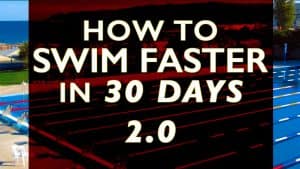I offer a FREE Swim Analysis. Click on the image to find out how you can send me a swim video.
Once I get your video I will do a voice and demonstration analysis and Dave will edit my voice over your video.
What I am looking at
Body alighment and rotation How and how often you breath, how you kick will impact your balance, alignment, and rotation. Are your gazing down, when you rotate to breath is your neck in alignment with your spine, your body nice and straight on the surface of the water? Are you rotating on your hip to breath or lifting your head/neck?
Common breathing mistakes I see from swimmers include not rotating on their hip to breathe, instead, they push down with their arm and lift their head. Dropping your arm when they rotate to inhale causes a lost propulsive force and split kick their legs for balance.
The flutter kick stems from the quads and hip flexors, kick up and down with flexible ankles. The advantage of a kick is that it creates the balance needed to have a good stroke rhythm, as a triathlete not for propulsion.
With the proper breathing, body balance and kick drills you can move effortlessly though the water
Next, I look at the three main phases of the stroke.
Recovery
Recovery is what goes on when your arm is out of the water. Common mistakes I see is wide and flat arm vs high elbow and leading with their hand (due to lack of rotation), vs leading with their elbow. High elbow recovery sets up with a nice hand entry. Are you leading, reaching, with your hand or elbow? If you enter the water very flat and shallow, arm and elbow at the same time, then you are setting yourself up for an ineffection catch and push (propulsion)
Hand Entry
The way you set up your hand enters the water can make or break your stroke and starts with high elbow recovery, fingertips, below your wrist, below your elbow.
A great entry has your fingers entering the water first, followed by your palm, then your wrist, forearm and finally your elbow. In order to enter cleanly, you need to get your elbow high on the recovery and aim to “spear” your hand in on the entry before rotating, the rotation helps extend arm after entry
Catch and push The Pull
The underwater pull includes the setup, also known as the “catch” followed by the push, pulling the greatest amount of water with each stroke to propel yourself. After entry, fingers are pointed down, elbow bent which sets you up to push water straight back towards feet, past your hip. Lack of any power/force behind your pull will cause your hip rotation to be off, the pull drives hip rotatio). Common mistakes I see is an athlete reaching with their hand before entry, dropping their elbow and are not pushing their palm past their elbow, past their hip.
Swimming is a technique, strength sport. Technique includes breathing, kicking, high elbow recovery, fingertip entry, catch and push. Strength includes extending from behind, pushing past hip and scrap thigh with every arm stroke. After you have the technique and strength, with appropriate swim workouts developing endurance, strength, threshold, and speed, increase your arm cadence without losing power and strength and you will be faster.
Related Articles:
How to Prepare for Open Water Swimming
Swimming Made Easy with Over 101 Swim Workouts
Is Kicking Critical To Success?

